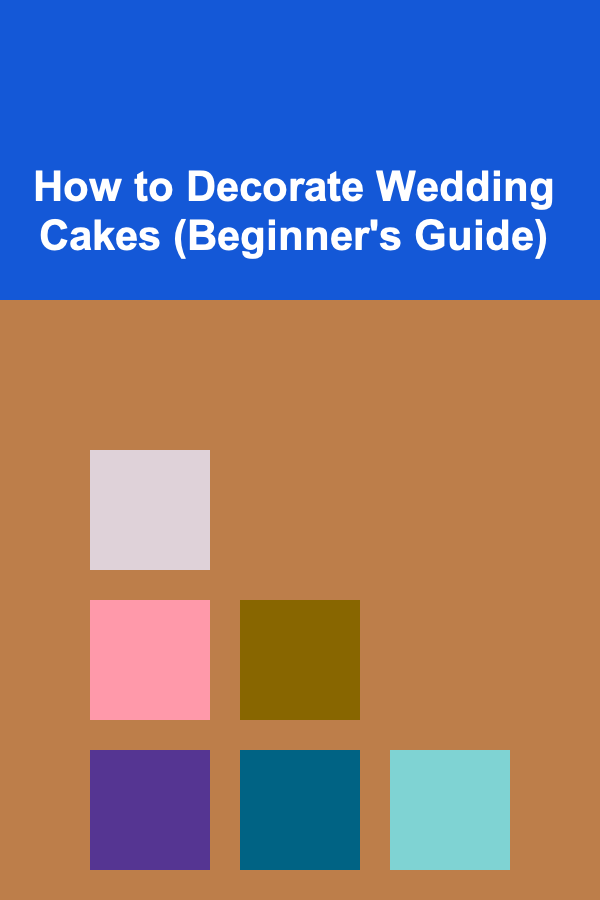
How to Decorate Wedding Cakes (Beginner's Guide)
ebook include PDF & Audio bundle (Micro Guide)
$12.99$9.99
Limited Time Offer! Order within the next:

Wedding cakes are not just a dessert; they are an important part of the celebration. They symbolize love, joy, and the start of a new chapter in the couple's life. For many bakers, decorating wedding cakes is a passion and a craft that takes practice, creativity, and a keen eye for detail. Whether you're an aspiring cake decorator or simply want to try your hand at creating a stunning wedding cake for a loved one, this beginner's guide will help you understand the basics and techniques needed to decorate wedding cakes beautifully.
Getting Started with Wedding Cake Decoration
Before diving into the intricate details of cake decoration, it's essential to understand the basics of cake preparation. A wedding cake must not only look beautiful but also taste delicious, so it's crucial to begin with a solid foundation. This includes baking the cake layers, making the right fillings, and ensuring that the structure can support the layers.
Step 1: Choose Your Cake Flavor and Filling
The flavor of the cake is just as important as its appearance. Wedding cake flavors can range from traditional vanilla and chocolate to more creative options like red velvet, lemon, or almond. Popular fillings include buttercream, ganache, fruit preserves, and cream cheese frosting. The couple's preferences and the theme of the wedding often guide the choice of cake flavor.
- Classic Flavors: Vanilla, chocolate, and lemon remain the most popular flavors for wedding cakes.
- Innovative Flavors: Red velvet, salted caramel, and coconut can add a unique touch to the cake.
- Fillings: The choice of filling should complement the cake flavor. For instance, lemon cake pairs beautifully with a raspberry filling, while chocolate cake is often paired with a rich ganache or cream cheese frosting.
Once you've decided on the cake flavor and filling, you'll want to ensure the layers are baked evenly. This is a critical aspect of cake decoration because a lopsided or undercooked cake will be difficult to decorate beautifully.
Step 2: Baking the Wedding Cake Layers
Baking the perfect cake layers is crucial for the final presentation. Wedding cakes are often multi-tiered, so the consistency of each layer is important to ensure they fit together properly.
- Select the Right Pan Sizes: Wedding cakes are usually made of multiple layers. Choose pan sizes that will give you the height and structure you need. Common sizes are 6, 8, 10, and 12-inch round pans.
- Level the Cake Layers: After baking, use a cake leveler or a serrated knife to level the tops of the cakes. This ensures each layer is even and flat, which is important for stacking.
- Cool the Cakes Properly: Allow the cakes to cool completely before decorating them. This helps the frosting to set properly and prevents the layers from becoming too soft and unstable.
Step 3: Choosing the Cake Decoration Style
The style of cake decoration you choose will set the tone for the wedding. A traditional wedding cake might feature elegant fondant or buttercream decorations, while a modern wedding cake could have a more minimalistic or whimsical design.
Wedding Cake Decoration Styles:
- Classic Buttercream Frosting: Buttercream is the most common choice for wedding cake decoration. It's versatile, easy to work with, and can be used to create smooth finishes or intricate piping designs.
- Fondant: Fondant is a smooth, pliable icing that gives cakes a sleek and polished look. It is often used for more sophisticated, formal cakes and can be molded into various shapes and figures.
- Naked Cakes: A trendy alternative to the traditional wedding cake, naked cakes have minimal frosting, showcasing the layers of cake. They are often decorated with fresh flowers or fruit for a rustic, modern look.
- Watercolor Cakes: Using a combination of food coloring and buttercream, watercolor cakes are painted to give the appearance of soft, colorful brush strokes.
- Themed Decorations: Many couples choose wedding cake designs that reflect their personalities or the theme of the wedding, such as floral patterns, metallic accents, or seasonal elements like autumn leaves or spring blossoms.
Step 4: Preparing Your Decorating Tools
Before you start decorating, gather all the necessary tools to ensure smooth and precise application of frosting, fondant, and decorations. Here's a list of the basic tools you'll need:
- Offset Spatula: This is the best tool for smoothing buttercream or fondant onto the cake layers.
- Piping Bags and Tips: Piping bags are essential for creating intricate designs, including rosettes, lace, and borders. Make sure you have different piping tips for various effects.
- Cake Leveler: This tool helps you evenly level your cake layers before frosting them.
- Turntable: A cake turntable allows you to rotate the cake as you decorate it, ensuring a smooth and even finish.
- Fondant Tools: If you're using fondant, you'll need rolling pins, fondant smoothers, and fondant cutters for creating clean and precise shapes.
Step 5: Frosting the Cake
Frosting the cake is where the magic happens. Whether you're using buttercream or fondant, the first step is to create a crumb coat, a thin layer of frosting that seals in the crumbs and provides a smooth surface for the final layer of frosting.
- Crumb Coating: Apply a thin layer of frosting to the entire cake using an offset spatula. Once the crumb coat is applied, chill the cake for about 30 minutes to firm up the frosting before adding the final layer.
- Final Coat: Apply a thick, even layer of frosting over the crumb coat. Use a bench scraper or an offset spatula to smooth the frosting to perfection.
If you're using fondant, it's essential to roll the fondant thin enough to cover the cake without tearing. Once the fondant is draped over the cake, smooth it out with a fondant smoother to eliminate any air bubbles and create a flawless finish.
Step 6: Adding Decorative Elements
Now that the cake is frosted, it's time to add the decorative elements that will elevate its appearance. There are endless possibilities when it comes to cake decoration, but here are a few common techniques:
- Piping: Use piping bags to create decorative elements such as rosettes, borders, and lace designs. Practice your piping skills on parchment paper before working on the cake itself.
- Sugar Flowers: Sugar flowers are beautiful and delicate creations that can be made using gum paste or fondant. They can be designed to match the wedding's floral theme and add a sophisticated touch to the cake.
- Fresh Flowers: If you're aiming for a more natural look, fresh flowers can be a stunning addition. Just be sure that the flowers you choose are non-toxic and safe for consumption.
- Edible Pearls and Metallic Accents: For a touch of elegance, consider adding edible pearls or metallic gold or silver leaf to the cake.
- Ribbons and Toppers: Ribbons, cake toppers, and figurines can add personality and flair to the cake. These decorations should complement the wedding theme.
Step 7: Assembling Multi-Tiered Cakes
If you're decorating a multi-tiered wedding cake, the assembly process requires extra care. The key to stacking tiers safely is ensuring that each layer is supported and stable. Here's how to assemble a multi-tiered cake:
- Dowels and Cake Boards: Place a cake board beneath each tier. To support the weight of the upper layers, insert dowels into the cake layers to prevent collapsing.
- Stacking: Start with the largest tier at the bottom and carefully stack the smaller tiers on top. Ensure the tiers are centered and stable.
- Final Touches: After stacking, use additional frosting or decorations to cover any seams between the tiers and give the cake a polished appearance.
Step 8: Transporting the Cake
Once your cake is decorated and assembled, it's time to transport it to the wedding venue. Since wedding cakes are often large and delicate, proper transport is crucial.
- Cake Box or Carrier: Use a sturdy cake box or a specialized cake carrier for transport. If necessary, secure the cake inside the box with non-slip materials to prevent it from shifting.
- Chill the Cake: If possible, refrigerate the cake before transport, especially if it's made with perishable fillings like cream cheese. This will help maintain its shape and prevent any melting or sliding.
Final Tips for Wedding Cake Decoration
- Practice Makes Perfect: If you're new to cake decoration, practice on smaller cakes before attempting a wedding cake. This will help you gain confidence and improve your skills.
- Work in a Cool Environment: Cake decoration is best done in a cool, dry environment. Heat can cause buttercream and fondant to melt, so ensure your workspace is comfortable.
- Be Patient: Cake decoration can be time-consuming and requires patience. Take your time, and don't rush the process.
Conclusion
Decorating a wedding cake can be an incredibly rewarding experience. It's a blend of creativity, technique, and precision that results in a beautiful centerpiece for the celebration. By understanding the basics of baking, frosting, and decorating, you can create a stunning wedding cake that will wow the bride, groom, and their guests. Remember to practice, be patient, and most importantly, enjoy the process of bringing the couple's dream wedding cake to life!

How to Cut Back on Luxury Spending and Stick to Your Home Budget
Read More
How to Use Folding Furniture to Save Space
Read More
How to Use Home Security Apps to Keep Your Property Safe
Read More
How to Understand the Implications of Digital Immortality
Read More
How to Prepare for High-Altitude Adventures
Read More
How to Plan a Documentary Videography Project: Research & Interviews
Read MoreOther Products

How to Cut Back on Luxury Spending and Stick to Your Home Budget
Read More
How to Use Folding Furniture to Save Space
Read More
How to Use Home Security Apps to Keep Your Property Safe
Read More
How to Understand the Implications of Digital Immortality
Read More
How to Prepare for High-Altitude Adventures
Read More